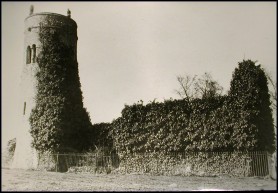| |
|
St
Andrew, Whitlingham
 |
|
Despite
being barely three miles from the centre of
Norwich, and a stone's throw from the new A47, St
Andrew at Whitlingham is rather hard to find,
because there is not access to it from either of
them. Rather, you need to head down the lane that
runs opposite Trowse Newton church for about
three miles, which becomes a track through the
country park. Right at the end, St Andrew
stands high on a ridge above the river Yare - or,
at least, some of it does. Some lies at the
bottom of the slope, covered in moss, while some
has presumably been carted away to be used as
building rubble.
We
know more about its history than many lost
churches. That it was round towered can be seen
in this 19th century postcard of the ruin,
donated by Martin Balls.
|
A bequest
in the 1520s left money for building an octagonal belfry
stage at the top of the round tower, but judging by the
photograph this was not built. After the Reformation, the
building seems to have been used less frequently,
possibly even actually allowed to ruin - which is
curious, since the window tracery on the south side of
the chancel is certainly Victorian. This is the side you
can see above, and I wondered if this 19th century
tracery could have been enthusiastic gothicisation to
create a view. James Noyes contacted me to note that this
window tracery was a feature added to what was already a
ruined church in the nineteenth century, in order to make
it more picturesque. Whitlingham was a favourite romantic
walking-spot in the 18th century for the city-folk, says
James, including the Norwich School of painters. The
church was therefore preserved as an ideal aesthetic
focal point.
One night
in 1940 the tower collapsed into the church, probably a
result of being undermined by land slipping away on the
north side. All that remains of the tower today is a
mound, and none of the north side survives at all. The
photograph at the top is taken from almost exactly the
same place as the postcard - the tower buttress on the
far left was under ivy in the 19th century.
The south
wall of the chancel stands, with two windows, and part of
the south wall of the nave. As well as the mysterious
19th century window, there is a pretty piscina, and
beside it the sedilia window has apparently been filled
up except for the tracery at the top. Pevsner's revising
editor Bill Wilson claims to have seen the east window
tracery, but either it has disappeared recently or he
didn't come and check. A couple of points of interest are
the brick built chancel arch - you can still see the
frill of decoration - and a 19th century graffito on the
south-west corner of the nave.
This must
have been a very lonely place until five years ago. Then,
the A47 dual carriageway between the Midlands and
Yarmouth was put in, shattering the peace. James Noyes
tells me that he wrote to the County Council in a vain
attempt to convince them to redirect the proposed
dual-carriageway because of this church site. The
official in charge claimed the church was predomintantly
Victorian (therefore of less architectural value); James
pointed out the piscina as proof that it was an important
mediaeval monument. But it was to no avail, and the
bypass was built next to the site, ignoring the protests
of the inhabitants of Postwick and ruining the
once-delightful village of Intwood.
However,
it does make access to the site easier, because the
locked gates that guard an access route from the lane up
to the verge of the dual carriageway also take you to the
flat area to the south of the church - presumably it was
used during construction of the road to store materials,
because there are now no older trees or bushes here. The
man who lives in the cottage in the lane observed us
trying the more difficult route up the north slope, and
advised us on the better way. Presumably he has had to
dial for an ambulance once too often.
I am
encouraged that, despite the obscurity of this church, it
generates a fair amount of correspondence, certainly as
much as some of Norfolk's more famous churches. People
seem to have a fascination with it. It remains a
difficult spot to get to, and spoilt a little by the
thunderous traffic of the A47.
Simon Knott, February 2005
|
|
|
